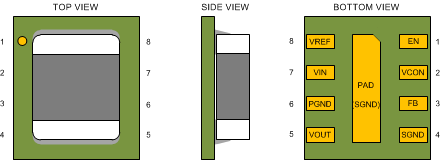JAJSB44H October 2011 – October 2023 LMZ10500
PRODUCTION DATA
- 1
- 1 特長
- 2 アプリケーション
- 3 概要
- 4 Revision History
- 5 Pin Configuration and Functions
- 6 Specifications
- 7 Detailed Description
- 8 Application and Implementation
- 9 Device and Documentation Support
- 10Mechanical, Packaging, and Orderable Information
パッケージ・オプション
デバイスごとのパッケージ図は、PDF版データシートをご参照ください。
メカニカル・データ(パッケージ|ピン)
- SIL|8
サーマルパッド・メカニカル・データ
発注情報
5 Pin Configuration and Functions
 Figure 5-1 SIL
Package,8-Pin µSIP
Figure 5-1 SIL
Package,8-Pin µSIPTable 5-1 Pin Functions
| PIN | TYPE(1) | DESCRIPTION | |
|---|---|---|---|
| NO. | NAME | ||
| 1 | EN | I | Enable input. Set this digital input higher than 1.2 V for normal operation. For shutdown, set low. Pin is internally pulled up to VIN and can be left floating for always-on operation. |
| 2 | VCON | I | Output voltage control pin. Connect to analog voltage from resisitve divider or DAC/controller to set the VOUT voltage. VOUT = 2.5 × VCON. Connect a small (470 pF) capacitor from this pin to SGND to provide noise filtering. |
| 3 | FB | I | Feedback of the error amplifier. Connect directly to output capacitor to sense VOUT. |
| 4 | SGND | I | Ground for analog and control circuitry. Connect to PGND at a single point. |
| 5 | VOUT | O | Output Voltage. Connected to one pin of the integrated inductor. Connect output filter capacitor between VOUT and PGND. |
| 6 | PGND | I | Power ground for the power MOSFETs and gate-drive circuitry. |
| 7 | VIN | I | Voltage supply input. Connect ceramic capacitor between VIN and PGND as close as possible to these two pins. Typical capacitor values are between 4.7 µF and 22 µF. |
| 8 | VREF | O | 2.35 V voltage reference output. Typically connected to VCON pin through a resistive divider to set the output voltage. |
| — | PAD | I | The center pad underneath the SIL0008A package is internally tied to SGND. Connect this pad to the ground plane for improved thermal performance. |
(1) I = input, O = output